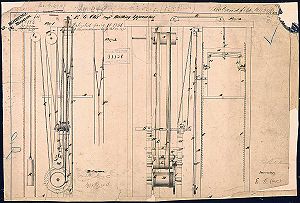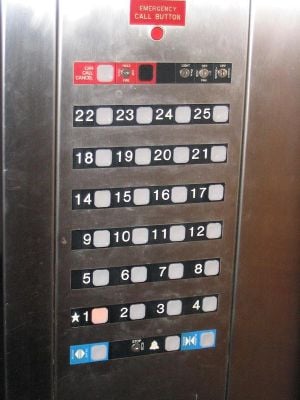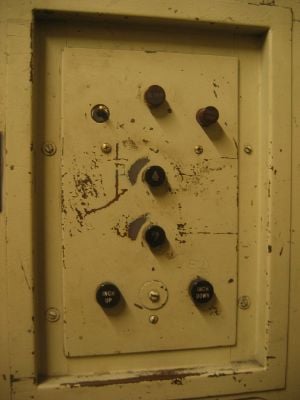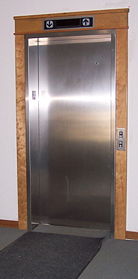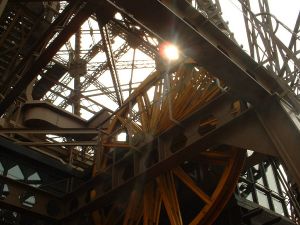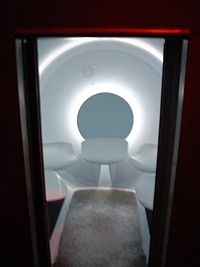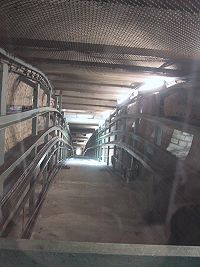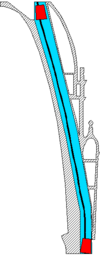Elevator
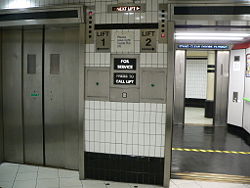
An elevator or lift is a transport device used to move goods or people vertically. Because of elevators, humankind has been able to create taller buildings. One of the biggest obstacles for tall buildings was the problem of transporting people to the upper floors. With elevators, that problem has been solved. Because of wheelchair access laws, elevators are often a requirement in new buildings with multiple floors.
Elevators are used to lift cargo and equipment; e.g. lifting aircraft to the flight deck of an aircraft carrier. There are even designs for a âspace elevatorâ that will be able to lift cargo and passengers into Earthâs upper atmosphere.
Design
Elevators began as simple rope or chain hoists. An elevator is essentially a platform that is either pulled or pushed up by a mechanical means. A modern day elevator consists of a cab (also called a "cage" or "car") mounted on a platform within an enclosed space called a âshaftâ (or in Commonwealth countries called a "hoistway"). In the past, elevator drive mechanisms were powered by steam and water hydraulic pistons.
In a "traction" elevator, cars are pulled up by means of rolling steel ropes over a deeply grooved pulley, called a âsheaveâ in the industry. The weight of the car is balanced with a counterweight. Sometimes two elevators always move synchronously in opposite directions, and they are each other's counterweight. The friction between the ropes and the pulley furnishes the traction that gives this type of elevator its name. See Traction elevators.
Hydraulic elevators use the principal of hydraulics to pressurize an above-ground or in-ground piston to raise and lower the car. Roped hydraulics use a combination of both ropes and hydraulic power to raise and lower cars. Recent innovations include permanent earth magnet motors, machine room-less rail mounted gearless machines, and microprocessor controls. See Hydraulic elevators.
Which technology is used in new installations depends on a variety of factors. Hydraulic elevators are cheaper, but installing cylinders greater than a certain length becomes impractical for very high elevator shafts. For buildings of much over seven stories, traction elevators must be employed instead. Hydraulic elevators are usually slower than traction elevators.
History
The first reference about the elevator is located in the works of the Roman architect Vitruvius, who reported that Archimedes built his first elevator, probably in 236 B.C.E. In some literary sources of later historical period lifts were mentioned as cabs, on the hemp rope and powered by hand or by animal's force. It is supposed that lifts of this type were installed in the Sinai monastery of Egypt.
In the seventeenth century the prototypes of elevators were located in the palace buildings of England and France. In 1793 Ivan Kulibin created the elevator with the screw lifting mechanism for the Winter Palace of Saint Petersburg. In 1816 the elevator was established in the main building of a sub-Moscow village called Arkhangelskoye. In 1823, an "ascending room" made its debut in London.[1]
In 1853, Elisha Otis introduced the safety elevator, which prevented the fall of the cab if the cable broke. The design of the Otis safety elevator is somewhat similar to one type still used today. A governor device engages knurled roller(s), locking the elevator to its guides should the elevator descend at excessive speed.
On March 23, 1857, the first Otis elevator was installed at 488 Broadway in New York City. The first elevator shaft preceded the first elevator by four years. Construction for Peter Cooper's Cooper Union building in New York began in 1853. An elevator shaft was included in the design for Cooper Union, because Cooper was confident that a safe passenger elevator would soon be invented. The shaft was circular because Cooper felt it was the most efficient design. Later Otis designed a special elevator for the school. Today the Otis Elevator Company, now a subsidiary of United Technologies Corporation, is the world's largest manufacturer of vertical transport systems, followed by Schindler, Thyssen-Krupp, Kone and Fujitec.
The first electric elevator was built by Werner von Siemens in 1880. The safety and speed of electric elevators were significantly enhanced by Frank Sprague.
The development of elevators was led by the need for movement of raw materials including coal and lumber from hillsides. The technology developed by these industries and the introduction of steel beam construction worked together to provide the passenger and freight elevators in use today.
In 1874, J. W. Meaker patented a method which permitted elevator doors to open and close safely U.S. patent 147,853 .
In 1929, Clarence Conrad Crispen, with Inclinator Company of America, created the first residential elevator. Crispen also invented the first inclined stairlift.
Elevator safety
Elevators are characterized as being extremely safe. Their safety record of moving millions of passengers every day, with extremely low rate of incident, is unsurpassed by any other vehicle systemâalthough fatalities due to malfunction have been known to occur on occasion. A certain number of passengers do die every year in elevator related incidents.[2] In 1998, in the United States, it was reported that of the estimated 120 billion rides per year in the approximately 600,000 elevators in the U.S., ten thousand people wound up in the emergency room.[3] because of elevator-related accidents. "Statistically, it's a safe ride," says Ray Lapierre, executive director of the Elevator Escalator Safety Foundation.[3]
Past problems with hydraulic elevators meant such elevators built prior to a code change in 1972 were subject to possible catastrophic failure. The code had previously required only single-bottom hydraulic cylinders; in the event of a breach of the cylinder, an uncontrolled fall of the elevator might result. Because it is impossible to verify the system completely without a pressurized casing (as described below), it is necessary to remove the piston to inspect it. The cost of removing the piston is such that it makes no economic sense to re-install the old cylinder, and therefore it is necessary to replace the cylinder and install a new piston.
In addition to the safety concerns for older hydraulic elevators, there is risk of leaking hydraulic oil into the aquifer and causing potential environmental contamination. This has led to the introduction of PVC liners (casings) around hydraulic cylinders which can be monitored for integrity.
In the past decade, recent innovations called machine room-less (MRL) elevators first developed by Kone called the EcoSpace,[4] have reduced the amount of overhead machinery required (the main disadvantage of the traction elevator) are gradually making hydraulic elevators obsolete. Today, MRL elevator models include the Kone EcoSpace, Mitsubishi ELENESSA, Otis Gen2, Fujitec Talon, ThyssenKrupp ISIS 2 and the Schindler 400A models. In Hong Kong, few hydraulic elevators remain and most companies only install hydraulic elevators as a special order. While the new machine room-less have proved good for space, a few companies have experienced major problems with quality control, such as limited travel to 300 feet with 40 floors, and engineering design when it comes to maintenance and replacement parts.
A continuing safety issue for passenger elevators is building fires, since people are likely to become trapped inside the elevator. Also, it cannot be relied upon as a means to escape. This can be detrimental for handicapped people who rely on elevator access. It is also detrimental to people in large skyscrapers where the only exit is to walk down many flights of stairs.
Uses of elevators
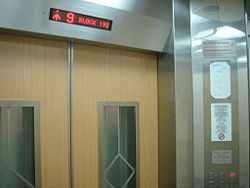
Passenger service
A passenger lift is designed to move people between a building's floors. This apparent simplicity belies a complex and sophisticated mechanical, electrical and microelectronic system.
Passenger elevators capacity is related to the available floor space. Generally passenger elevators are available in capacities from 1,000 to 5,000 pounds (455 to 2,270 kilograms) in 500-pound (230-kilogram) increments. Generally passenger elevators in buildings eight floors or less are hydraulic which can reach speeds up to 200 feet per minute (1 meter per second). In buildings up to ten floors, electric & gearless elevators are likely to have speeds up to 500 feet per minute (2.5 meters per second), and above ten floors speeds begin at 500 feet per minute (2.5 meters per second) up to 2000 feet per minute (10 meters per second).
Sometimes passenger elevators are used as a city transport along with funiculars. For example, there is a 3-station underground public elevator in Yalta, Ukraine, which takes passengers from the top of a hill above the Black Sea on which hotels are perched, to a tunnel located on the beach below.
Types of passenger elevators

Passenger elevators may be specialized for the service they perform, including: Hospital emergency, front and rear entrances, double-decker, and other uses. Cars may be ornate in their interior appearance, may have audio visual advertising, and may be provided with specialized recorded voice instructions.
An express elevator does not serve all floors. For example, it moves between the ground floor and a skylobby, or it moves from the ground floor or a skylobby to a range of floors, skipping floors in between.
Entrapment
All elevators are required to have communication connection to an outside 24-hour emergency service, automatic recall capability in a fire emergency, and special access for firefighters' use in a fire. Elevators should not be used by the public if there is a fire in or around the building. Numerous building codes requires signs near the elevator to state "Use stairs in case of fire." However, some countries do allow the use of elevators during emergency evacuation.
Capacity
Residential elevators may be small enough for one person while some are large enough for more than a dozen.
Wheelchair or platform lifts, a specialized type of elevator designed to move a wheelchair 6 feet (2 meters) or less, often can accommodate just one person in a wheelchair at a time with a maximum load of 750 pounds (340 kilograms).
Freight elevators
A freight elevator (or goods lift) is an elevator designed to carry goods, rather than passengers. Freight elevators are often exempt from some code requirements. Freight elevators or service elevators (goods or service lifts) may be exempt from some of the requirements for fire service. However, new installations would likely be required to comply with these requirements. Freight elevators are generally required to display a written notice in the car that the use by passengers is prohibited, though certain freight elevators allow dual use through the use of an inconspicuous riser.
Freight elevators are typically larger and capable of carrying heavier loads than a passenger elevator, generally from 2,300 to 4,500 kilograms. Freight elevators may have manually operated doors, and often have rugged interior finishes to prevent damage while loading and unloading. Although hydraulic freight elevators exist, electric elevators are more energy efficient for the work of freight lifting.
Stage and orchestra lifts are specialized lifts for use in the performing arts, and are often exempt from some requirements. Local jurisdictions may govern their use, installation and testing, however they are often left out of local code enforcement provisions due to their infrequent installation.
Vehicle elevators
A car elevator is installed where ramps are considered space-inefficient for smaller buildings (usually in apartment buildings where frequent access is not an issue). The car platforms are raised and lowered by chained steel gears (resembling bicycle chains in appearance). In addition to the vertical motion, the platforms can rotate about its vertical axis (up to 180 degrees) to ease driver access and/or accommodate building plans. Most parking lots of this type are unable to accommodate taller vehicles.
In spite of the sheer size of the car platform and its perceived "passenger capacity," there are huge passenger and freight lifts that can accommodate more than the rated capacity of the car lift.
Boat elevators
Boats and small ships can pass between different levels of a canal with a boat lift in some smaller canals rather than through a canal lock.
Aircraft elevators
On aircraft carriers, elevators carry aircraft between the flight deck to the hangar deck for operations or repairs. These elevators are designed for much greater capacity than any other elevator ever built, up to 200,000 pounds of aircraft and equipment. Smaller elevators lift munitions to the flight deck from magazines deep inside the ship.
Dumbwaiter
A small freight elevator is often called a dumbwaiter, often used for the moving of small items such as dishes in a 2-story kitchen or books in a multi-story rack assembly. Passengers are never permitted on dumbwaiters. Dumbwaiters are required to comply with ASME A17.1 in most U.S. and Canadian jurisdictions.
Modern dumbwaiters are generally driven by a small electric motor with a counterweight and their capacity is limited to about 750 pounds (340 kilograms). Dumbwaiters are used extensively in the restaurant business (hence the name) and may also be used as book lifts in libraries, or to transport mail or similar items in an office tower. Dumbwaiters that comply with the ASME A17.2 can withstand heavy loads of up to 1,000 pounds.
Dumbwaiters, especially older ones, may also be hand operated using a roped pulley, and they are often found in Victorian-era houses, offices and other establishments when such devices were at their peak.
Rope pulley dumbwaiters frequently appear in fiction with a period setting, especially fiction set in Aristocratic country houses. The dumbwaiters often act as a physical and metaphorical link between the servants toiling in the kitchens below and the masters and mistresses dining in the room above, who never see the person that prepared their meal. In action-based period stories they serve the same dramatic purpose that ventillation shafts do in more modern settings by allowing characters to move through a building unnoticed, even if such movement would be difficult or impossible with a real life dumbwaiter. For example the Doctor Who story The Talons Of Weng-Chiang sees two of its heroes escape by hauling themselves up in a dumbwaiter in a Victorian-era laundry, and the first Tomb Raider film depicts Lara Croft escaping her pursuers through the dumbwaiter shaft of her ancient family home.
Material handling belts and belt elevators
A different kind of elevator is used to transport raw materials. It generally consists of an inclined plane on which a conveyor belt runs. The conveyor often includes partitions to prevent the material from sliding backwards. These elevators are often used in industrial and agricultural applications. When such mechanisms (or spiral screws or pneumatic transport) are used to elevate grain for storage in large vertical silos, the entire structure is called a grain elevator.
There have occasionally been lift belts for humans; these typically have steps about every seven feet along the length of the belt, which moves vertically, so that the passenger can stand on one step and hold on to the one above. These belts are sometimes used, for example, to carry the employees of parking garages, but are considered too dangerous for public use.
Types of elevator hoist mechanisms
In general, there are three means of moving an elevator:
Traction elevators
Geared traction machines are driven by AC or DC electric motors. Geared machines use worm gears to control mechanically movement of elevator cars by "rolling" steel hoist ropes over a drive sheave which is attached to a gearbox driven by a high speed motor. These machines are generally the best option for basement or overhead traction use for speeds up to 1,000 feet per minute (5 meters per second).
Gearless Traction machines are low speed (low RPM), high torque electric motors powered by AC or DC. In this case, the drive sheave is directly attached to the end of the motor. A brake is mounted between the motor and drive sheave (or gearbox) to hold the elevator stationary at a floor. This brake is usually an external drum type and is actuated by spring force and held open electrically; a power failure will cause the brake to engage and prevent the elevator from falling (see inherent safety and safety engineering).
In each case, cables are attached to a hitch plate on top of the cab or may be "underslung" below a cab, and then looped over the drive sheave to a counterweight attached to the opposite end of the cables which reduces the amount of power needed to move the cab. The counterweight is located in the shaft and rides a separate rail system; as the car goes up, the counterweight goes down, and vice versa. This action is powered by the traction machine which is directed by the controller, typically a relay logic or computerized device that directs starting, acceleration, deceleration and stopping of the elevator cab. The weight of the counterweight is typically equal to the weight of the elevator cab plus 40-50 percent of the capacity of the elevator. The grooves in the drive sheave are specially designed to prevent the cables from slipping. "Traction" is provided to the ropes by the grip of the grooves in the sheave, thereby the name. As the ropes age and the traction grooves wear, some traction is lost and the ropes must be replaced and the sheave repaired or replaced.
Some elevators have a system called compensation. This is a separate set of cables or a chain attached to the bottom of the counterweight and the bottom of the elevator cab. This makes it easier to control the elevator, as it compensates for the differing weight of cable between the hoist and the cab. If the elevator cab is at the top of the shaft, there is a short length of hoist cable above the car and a long length of compensating cable below the car and vice versa for the counterweight. If the compensation system uses cables, there will be an additional sheave in the pit below the elevator, to guide the cables. If the compensation system uses chains, the chain is guided by a bar mounted between the counterweight rails.
Hydraulic elevators
Conventional hydraulic elevators were first developed by Dover Elevator (now ThyssenKrupp Elevator). They are quite common for low and medium rise buildings (2-9 floors) and use a hydraulically powered plunger to push the elevator upwards. On some, the hydraulic piston (plunger) consists of telescoping concentric tubes, allowing a shallow tube to contain the mechanism below the lowest floor. On others, the piston requires a deeper hole below the bottom landing, usually with a PVC casing (also known as a caisson) for protection.
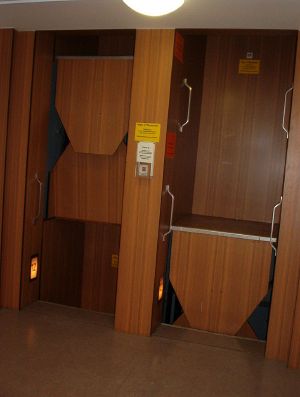
- Roped hydraulic elevators use a combination of ropes and hydraulics.
- Twin post hydraulic provides higher travel with no underground hole.
- Holeless hydraulic elevators do not require holes to be dug for the hydraulic cylinder. In most designs, the cab is lifted by a pair of hydraulic jacks, one on each side of the elevator.
Climbing elevator
A climbing elevator is a self-ascending elevator with its own propulsion. The propulsion can be done by an electric or a combustion engine. Climbing elevators are used in guyed masts or towers, in order to make easy access to parts of these constructions, such as flight safety lamps for maintenance.
Paternoster
A special type of elevator is the paternoster, a constantly moving chain of boxes. A similar concept moves only a small platform, which the rider mounts while using a handhold and was once seen in multi-story industrial plants.
Controlling elevators
General controls
A typical modern passenger elevator will have:
- Call buttons to choose a floor. Some of these may be key switches (to control access). In some elevators, certain floors are inaccessible unless one swipes a security card or enters a passcode (or both). In the United States and other countries, call button text and icons are raised to allow blind users to operate the elevator; many have Braille text besides.
- Door open and door close buttons to instruct the elevator to close immediately or remain open longer. In some elevators, holding the door open for too long will trigger an audible alarm (this alarm might confuse some people to think that the elevator is overloaded or otherwise broken).
- A stop switch (this is not allowed under British regulations) to halt the elevator (often used to hold an elevator open while freight is loaded). Keeping an elevator stopped for too long may trigger an alarm. Often, this will be a key switch.
- An alarm button or switch, which passengers can use to signal that they have been trapped in the elevator.
Some elevators may have one or more of the following:
- An elevator telephone, which can be used (in addition to the alarm) by a trapped passenger to call for help.
- A fireman's key switch, which places the elevator in a special operating mode designed to aid firefighters.
- A medical emergency key switch, which places the elevator in a special operating mode designed to aid medical personnel.
- Security controls: Elevators in modern buildings incorporate security features to control / prevent unauthorized floor access. One method is to use RFID card access in which call buttons don't register until an authorized card is detected. Another method is to require the passenger to enter a code, either on a separate keypad or the call buttons themselves, followed by the desired floor number.
- Hold button: This button delays the door closing timer, useful for loading freight and hospital beds.
- Cancel floor: Passengers can cancel floor destinations on some models by double clicking the buttons. If no other floors are registered in the travelling direction, the elevator will line up with the nearest floor at its present location. It may or may not open its doors; this behavior is as observed onboard Mitsubishi Elevators.
Other controls, which are generally inaccessible to the public (either because they are key switches, or because they are kept behind a locked panel, include:
- Switches to control the lights and ventilation fans in the elevator.
- An inspector's switch, which places the elevator in inspection mode (this may be situated on top of the elevator)
- An independent service will prevent the car from answering to hall calls and only arrive the selected floors in the panel. The door may stay open while parked on a floor.
- Up and down buttons, to move the car up and down without selecting a specific floor. Some older elevators can only be operated this way.
- PASS button: When used by elevator attendants (given access to the operator panel), causes the car to not answer hall calls while the button is depressed. This feature may also be automatically activated if the elevator computer detects that the car is near its full capacity.
- GO button: Useful for attendant serviced elevators, this button is used to close doors and start the elevator, where it woud be waiting with the doors open.
Controls in early elevators
- Some older freight elevators are controlled by switches operated by pulling on adjacent ropes. Safety interlocks ensure that the inner and outer doors are closed before the elevator is allowed to move.
- Early elevators had no automatic landing positioning. Elevators were operated by elevator operators using a motor controller. The controller was contained within a cylindrical container about the size and shape of a cake container and this was operated via a projecting handle. This allowed some control over the energy supplied to the motor (located at the top of the elevator shaft or beside the bottom of the elevator shaft) and so enabled the elevator to be accurately positionedâif the operator was sufficiently skilled. More typically the operator would have to "jog" the control to get the elevator reasonably close to the landing point and then direct the outgoing and incoming passengers to "watch the step." After stopping at the landing the operator would open the door/doors. Manually operated elevators were generally refitted or the cabs replaced by automatic equipment by the 1950s.
- Large buildings with multiple elevators of this type would also have an elevator dispatcher stationed in the lobby to direct passengers and to signal the operator to leave with the use of a mechanical "cricket" noisemaker.
- Some elevators still in operation have pushbutton manual controls.
External controls
Elevators are typically controlled from the outside by up and down buttons at each stop. When pressed at a certain floor, the elevator arrives to pick up more passengers. If the said elevator is currently serving traffic in a certain direction, it will only answer hall calls in the same direction unless there are no more calls beyond that floor.
In a group of two or more elevators, the call buttons may be linked to a central dispatch computer, such that they illuminate and cancel together. This is done to ensure that only one car is called at one time.
Key switches may be installed on the ground floor so that the elevator can be remotely switched on or off from the outside.
The elevator algorithm
The elevator algorithm, a simple algorithm by which a single elevator can decide where to stop, is summarized as follows:
- Continue traveling in the same direction while there are remaining requests in that same direction
- If there are no further requests in that direction, then stop and become idle, or change direction if there are requests in the opposite direction
The elevator algorithm has found an application in computer operating systems as an algorithm for scheduling hard disk requests. Modern elevators use more complex heuristic algorithms to decide which request to service next.
Computer dispatched
Efficiencies of multiple elevators installed in an office building may increase if a central dispatcher is used to group passengers going to the same floor to the same elevator. In the industry, this is known as the destination floor control system. In buildings with these computer-dispatched elevator systems, passengers key in their destination floor in a central dispatch panel located at the building lobby. The dispatch panel will then tell the passenger which elevator to use. Inside the elevator there is no call button to push (or the buttons are there but they cannot be pushed; they only indicate stopping floors).
The system was first pioneered by Schindler Elevator as the Miconic 10. Manufacturers of such systems claim that average traveling time can be reduced by up to 30 percent. There are some problems with the system, though. Sometimes, one person enters the destination for a large group of people going to the same floor. The dispatching algorithm is usually unable to completely cater for the variation, and late comers may find the elevator they are assigned to is already full. Also, occasionally, one person may press the floor multiple times. This is common with up/down buttons when people believe this to hurry elevators. However, this will make the computer think multiple people are waiting and will allocate empty cars to serve this one person.
Destination elevators are computer controlled for maximum efficiency of the system. At each floor there is a keypad where the rider selects which floor they wish to go to. The system then directs the passenger to an elevator that will be stopping at their floor. There are no floor buttons inside a destination elevator.
Special operating modes
Up peak
During âUp Peakâ mode, elevator cars in a group are recalled to the lobby to provide expeditious service to passengers arriving at the building, most typically in the morning as people arrive for work or at the conclusion of a lunch-time period. Elevators are dispatched one-by-one when they reach a pre-determined passenger load, or when they have had their doors opened for a certain period of time. The next elevator to be dispatched usually has its hall lantern or a "this car leaving next" sign illuminated to encourage passengers to make maximum use of the available elevator system capacity.
The commencement of Up Peak may be triggered by a time clock, by the departure of a certain number of fully loaded cars leaving the lobby within a given time period, or by a switch manually operated by a building attendant.
Down peak
During âDown Peakâ mode, elevator cars in a group are sent away from the lobby towards the highest floor served, after which they commence running down the floors in response to hall calls placed by passengers wishing to leave the building. This allows the elevator system to provide maximum passenger handling capacity for people leaving the building.
The commencement of Down Peak may be triggered by a time clock, by the arrival of a certain number of fully loaded cars at the lobby within a given time period, or by a switch manually operated by a building attendant.
Sabbath service
In areas with large populations of observant Jews, one may find a "Sabbath elevator." In this mode, an elevator will stop automatically at every floor, allowing people to step on and off without having to press any buttons. Regenerative braking is also disabled if it is normally used, shunting energy collected from downward travel, and thus the gravitational potential energy of passengers, into a resistor network. This prevents violation of the Sabbath prohibition against doing useful work.[5]
Independent service
Independent service is a special service mode found on most elevators. It is activated by a key switch either inside the elevator itself or on a centralized control panel. When an elevator is placed on independent service, it will no longer respond to hall calls. In a bank of elevators, traffic would be rerouted to the other elevators, while in a single elevator, the hall buttons will be disabled. The elevator will remain parked on a floor with its doors open until a floor is selected and the door close button is held until the elevator starts to travel. Independent service is useful when transporting large goods or moving groups of people between certain floors.
Inspect mode
Inspect mode is a mode that is activated only by a key switch that is usually located inside the elevator on the control operating panel. When activated, the elevator will no longer respond to calls and comes immediately to a halt. In theory, this mode could be used as a way to stop the car in mid-flight if one did not have a stop switch key. The elevator car will continue to remain idle until given a command from a corresponding access key switch.
Key switches for access are usually located at the bottom floor and top floor. This enables the elevator mechanic to gain access to the pit of the elevator or the car top. The access key switch will bypass the door lock circuit for the floor it is located on and allow the car to move at inspection speed. This speed can range from anywhere up to 60 percent of contract speed on most controllers. Since this key allows entry into the hoist way of the elevator, this key is not given out and is restricted only for use by qualified elevator mechanics.
Another type of inspect is called car top inspection mode. Most modern elevators have a car top inspect station on the top of the car that will isolate the landing and car push stations. There are three main control buttons fitted to the station that consists of an up button, down button and run button, all work as dead-man buttons (i.e. no pressure on the buttons means no car movement). The run button has to be activated along with a direction button. This test station usually has a light, alarm button, stop button and close access to the door operating control. The speed that a car on inspection runs at is defined by local code.
Fire service mode
Depending on the location of the elevator, fire service code will vary state to state and country to country. Fire service is usually split up into two modes. Phase one and phase two are separate modes that the elevator can go into.
Phase one mode is activated by a corresponding smoke sensor or heat sensor in the building. Once an alarm has been activated, the elevator will automatically go into phase one. The elevator will wait an amount of time, and then proceed to go into nudging mode to tell everyone the elevator is leaving the floor. Once the elevator has left the floor, depending on where the alarm was set off, the elevator will go to the fire recall floor.
However, if the alarm was activated on the fire recall floor the elevator will have an alternate floor to recall to. When the elevator is recalled, it proceeds to the recall floor and stops with its doors open. The elevator will no longer respond to calls or move in any direction. Located on the fire recall floor is a fire service key switch. The fire service key switch has the ability to turn fire service off, turn fire service on or to bypass fire service. The only way to return the elevator to normal service is to switch it to bypass after the alarms have reset.
Phase two mode can only be activated by a key switch located inside the elevator on the centralized control panel. This mode was created for firefighters so that they may rescue people from a burning building. The phase two key switch located on the panel has three positions: off, on, and hold. By turning phase two on, the firefighter enables the car to move. However, like independent service mode, the car will not respond to a car call unless the firefighter manually pushes and holds the door close button. Once the elevator gets to the desired floor it will not open its doors unless the firefighter holds the door open button, in case the floor is burning and the firefighter can feel the heat and knows not to open the door. The firefighter must hold door open until the door is completely opened. If for any reason the firefighter wishes to leave the elevator, they will use the hold position on the key switch to make sure the elevator remains at that floor. At anytime the firefighter wishes to return to the recall floor, they simply turn the key off and close the doors.
Elevator convenience features
In addition to the call buttons, elevators usually have floor indicators (often illuminated by LED) and direction lanterns. The former are almost universal in cab interiors with more than two stops and may be found outside the elevators as well on one or more of the floors. Floor indicators can consist of a dial with a rotating needle, but the most common types are those with successively illuminated floor indications or LCDs.
Direction lanterns are also found both inside and outside elevator cars, but they should always be visible from outside because their primary purpose is to help people decide whether or not to get on the elevator.
Direction indicators are sometimes etched with arrows or shaped like arrows and/or use the convention that one that lights up red means "down" and other colors mean "up" in systems that differentiate between color directions. Since the color convention is often undermined or overridden by systems that do not invoke it, it is usually used only in conjunction with other differentiating factors. Sometimes directions must be inferred by the position of the indicators relative to one another.
Standards
The mechanical, electrical and operational design of elevators are dictated according to various standards (elevator codes), which may typically be international, national, state, regional or city based. Where once many standards were prescriptive, specifying exact criteria which must be complied with, there has been a shift towards more performance-based standards where the onus falls on the designer to ensure that the elevator meets or exceeds the standard.
Some of the national elevator standards include:
- Australia â AS1735
- Canada â CAN/CSA B44
- Europe â EN 81 series (EN 81-1, EN 81-2, EN 81-28, EN 81-70, EN 12015, EN 12016, EN 13015, etc.)
- U.S. â ASME A17
Because an elevator is part of a building, it must also comply with standards relating to earthquake resilience, fire standards, electrical wiring rules and so forth.
Additional requirements relating to access by disabled persons may be mandated by laws or regulations such as the Americans with Disabilities Act.
U.S. and Canadian elevator standard specifics
Passenger elevators are required to conform to the American Society of Mechanical Engineer's Standard A17.1 Safety Code for Elevators and Escalators in most U.S. and Canadian jurisdictions (In Canada the document is the CAN/CSA B44 Safety Standard which was harmonized with the U.S. version in the 2000 edition). In addition, passenger elevators may be required to conform to the requirements of A17.3 for existing elevators where referenced by the local jurisdiction. Passenger elevators are tested using the ASME A17.2 Standard. The frequency of these tests is mandated by the local jurisdiction, which may be a town, city, state or provincial standard.
Passenger elevators must also conform to many ancillary building codes including the local or state building code, National Fire Protection Association standards for electrical, fire sprinklers and fire alarm systems, plumbing codes, and HVAC codes. In addition passenger elevators are required to conform to the Americans with Disabilities Act and other state and federal civil rights legislation regarding accessibility.
Residential elevators are required to conform to ASME A17.1. Platform and wheelchair lifts are required to comply with ASME A18.1 in most U.S. jurisdictions.
Most elevators have a location in which the permit for the building owner to operate the elevator is displayed. While some jurisdictions require the permit to be displayed in the elevator cab, other jurisdictions allow for the operating permit to be kept on file elsewhereâsuch as the maintenance officeâand to be made available for inspection on demand. In such cases, instead of the permit being displayed in the elevator cab, often a notice is posted in its place informing riders of where the actual permits are kept.
Notable Elevator Installations, by Location
- Eiffel Tower
The Eiffel Tower has double-deck elevators built into the legs of the tower, serving the ground level to the first and second levels. Even though the shaft runs diagonally upwards with the contour of the tower, both the upper and lower cars remain horizontally level. The offset distance of the two cars changes throughout the journey.
There are four elevator cars of the traditional design that run from the second level to the third level. The cars are connected to their opposite pairs (opposite in the elevator landing/hall) and use each other as the counterweight. As one car ascends from level 2, the other descends from level 3. The operations of these elevators are synchronized by a light signal in the car.
- Taipei 101
Taipei 101 uses double-deck elevators to service the main building tenants, although it is not the first of such implementations. Within the building are several sky lobbies accessible via non-stop service elevators; after which the tenants must transfer elevators to reach their floor. Each sky lobby is also equipped with the "floor dispatch" system as described above.
The observation deck elevators are the fastest in the world. They accelerate to a top speed of 1,010 meters per minute in 16 secondsâafter which it begins to slow down for the arrival to the observation deck. The upward journey from fifth floor to 89th floor is 352 meters long, and is completed in a matter of 37 seconds. The downward journey is completed at a reduced speed throughout.
The car and its counterweight are shaped like a bullet-train to minimize traveling noise. The cabin features a pair of interactive displays showing the car's vertical position in the tower, along with floor, altitude, timer, and vertical speed. Further, the cabin is pressurized to enhance passenger comfort in adapting to rapid changes in air pressure.
- The Gateway Arch
The Gateway Arch in Saint Louis, Missouri has a unique elevator system which carries passengers from the visitors center underneath the arch to the observation deck at the top of the structure.
Called a tram or tramway, people enter this unique tramway much as one would enter an ordinary elevator, through double doors. Passing through the doors the passengers in small groups enter a horizontal cylindrical compartment containing seats on each side and a flat floor. A number of these compartments are linked to form a train. These compartments each individually retain an appropriate level orientation by tilting while the entire train follows curved tracks up one leg of the arch.
There are two tramways within the arch, one at the north end, and the other at the south end. The entry doors have windows, so people traveling within the Arch are able to see the interior structure of the Arch during the ride to and from the observation deck.
- New city hall, Hanover, Germany
The elevator in the new city hall in Hanover, Germany is a technical rarity, and unique in Europe, as the elevator starts straight up but then changes its angle by 15 degrees to follow the contour of the dome of the hall. The cabin therefore tilts 15 degrees during the ride. The elevator travels a height of 43 meters. The new city hall was built in 1913. The elevator was destroyed in 1943 and rebuilt in 1954.
- Luxor Inclinator Elevator
The Luxor Casino, in Las Vegas, Nevada, features an elevator known as âthe Inclinator.â The shape of this casino is a pyramid. Therefore, the elevator travels up the side of the pyramid at a 39-degree angle.
- Twilight Zone Tower of Terror
The Twilight Zone Tower of Terror is the common name for a series of a free-fall elevator attractions at the Disney-MGM Studios park in Orlando, Disney's California Adventure park in Anaheim, the Walt Disney Studios Park in Paris and the Tokyo DisneySea park in Tokyo. The central element of this attraction is the unique free-fall experience achieved through the use of a state-of-the-art elevator system. For safety reasons, passengers are seated and secured in their seats rather than allowing them to stand. Unlike most traction elevators, the elevator car and counterweight are joined using a cable system in a continuous loop running through both the top and the bottom of the drop shaft. This allows the drive motor to pull down on the elevator car from underneath, a feature which is used to raise passengers out of their seats early in the drop sequence by applying downward acceleration in addition to that of gravity. Furthermore, the uniquely fast and powerful drive motor allows the elevator to ascend to the top in mere seconds.
Finally, the passenger cab is mechanically removed from the main elevator car so that the elevator shaft can efficiently be used continuously while the passenger cabs can alternatingly be removed to permit passenger boarding. The Disney-MGM Studios version of the attraction achieves this operation in a very different fashion than that of the other versions, although the end effect is similar. All of the attraction buildings feature multiple elevator shafts to further improve throughput. The doorways of the top few "floors" are open to the outdoor environment, offering a dramatic view for both the ride passengers and the street-level observers.
- "Top of the Rock" elevators
Guests ascending to the 67th, 69th, and 70th level observation decks (dubbed "Top of the Rock") atop the GE Building at Rockefeller Center in New York City ride a high-speed glass-top elevator. When entering the cab, it appears to be any normal elevator ride. However, once the cab begins moving, the interior lights turn off and a special blue light above the cab turns on. This lights the entire shaft, so riders can see the moving cab through its glass ceiling as it rises and lowers through the shaft. Music plays and various animations are also displayed on the ceiling. The entire ride takes about 60 seconds.
- Apple Store, New York City
Otis has recently installed an elevator that takes Apple customers from the 35-foot ground floor cube to the basement store. The elevator, except for the floor, is made completely of glass. On May 29, 2006, just a week after its opening, it made the news when it trapped five passengers.[6]
Elevator accidents
Maintenance is crucial for the safety of an elevator since they usually operate more than 20-30 years before replacement or modernization. Although elevators are a safe means of transport, accidents do sometimes happen, as with other machinery.[2] There have been a relatively small amount of accidents throughout the world, a handful of them being fatal. Of the fatal accidents, some of them were equipment malfunctions where the people stepped into open elevator shafts by accident. Only very few of them were instances of the car actually falling.
See also
- Escalator
- Grain elevator
- Funicular
- Paternoster
Notes
- â âWorldâs Fastest Elevator,â Popular Mechanics (March 2004). Retrieved June 28, 2007.
- â 2.0 2.1 Michael McCann, âDeaths and Injuries Involving Elevators and Escalators - A Report of the Center To Protect Workers' Rights (Revised),â The Center to Protect Workerâs Rights (2001, 2004). Retrieved June 28, 2007.
- â 3.0 3.1 Good Housekeeping, "The last word on elevator safety," 1998. Retrieved April 23, 2007.
- â KONE EcoSpace Elevators, Sweets Network. Retrieved June 28, 2007.
- â Ohr Somayach International, Ohr Somayach â Ask the Rabbi / Shabbat Elevators. Retrieved June 28, 2007.
- â Ryan Block, âJobs' glass elevator locks in group customers,â Engadget.com. Retrieved June 28, 2007.
ReferencesISBN links support NWE through referral fees
- Goetz, Alisa. Up, Down, Across: Elevators, Escalators, and Moving Sidewalks. London: Merrell. ISBN, 2003. 1858942136
- Smitherman, D. V., Jr. Space Elevators: An Advanced Earth-space Infrastructure for the New Millennium. Honolulu, HI: University Press of the Pacific, 2006. ISBN 1410225518
- Strakosch, George R. The Vertical Transportation Handbook. Hoboken, NJ: Wiley, 2001. ISBN 0471162914
External links
All links retrieved February 13, 2024.
- Elevators â Howstuffworks.com.
- The Lifting Operations and Lifting Equipment Regulations 1998 (LOLER) Guidance â United Kingdom
Credits
New World Encyclopedia writers and editors rewrote and completed the Wikipedia article in accordance with New World Encyclopedia standards. This article abides by terms of the Creative Commons CC-by-sa 3.0 License (CC-by-sa), which may be used and disseminated with proper attribution. Credit is due under the terms of this license that can reference both the New World Encyclopedia contributors and the selfless volunteer contributors of the Wikimedia Foundation. To cite this article click here for a list of acceptable citing formats.The history of earlier contributions by wikipedians is accessible to researchers here:
The history of this article since it was imported to New World Encyclopedia:
Note: Some restrictions may apply to use of individual images which are separately licensed.
